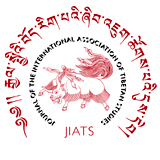
Tibetan Buddhism is a form of Buddhism practiced in Tibet, Bhutan and Mongolia. It also has a sizable number of adherents in the areas surrounding the Himalayas, including the Indian regions of Ladakh, Sikkim, and Arunachal Pradesh, as well as in Nepal. Smaller groups of practitioners can be found in Central Asia, Xinjiang, Inner Mongolia, and some regions of Russia, such as Tuva, Buryatia, and Kalmykia.

Longchen Rabjam Drimé Özer, commonly abbreviated to Longchenpa was a Tibetan scholar-yogi of the Nyingma school of Tibetan Buddhism. According to tibetologist David Germano, Longchenpa's work led to the dominance of the Longchen Nyingthig lineage of Dzogchen over the other Dzogchen traditions. He is also responsible for the scholastic systematization of Dzogchen thought within the context of the wider Tibetan Vajrayana tradition of philosophy which was highly developed at the time among the Sarma schools. Germano also notes that Longchenpa's work is "generally taken to be the definitive expression of the Great Perfection with its precise terminological distinctions, systematic scope, and integration with the normative Buddhist scholasticism that became dominant in Tibet during the thirteenth and fourteenth centuries."

Dzogchen, also known as atiyoga, is a tradition of teachings in Indo-Tibetan Buddhism and Bon aimed at discovering and continuing in the ultimate ground of existence. The goal of Dzogchen is knowledge of this basis, this knowledge is called rigpa. There are spiritual practices taught in various Dzogchen systems for awakening rigpa.

Padmasambhava, also known as Guru Rinpoche and the Lotus from Oḍḍiyāna, was a tantric Buddhist Vajra master from medieval India who taught Vajrayana in Tibet. According to some early Tibetan sources like the Testament of Ba, he came to Tibet in the 8th century and helped construct Samye Monastery, the first Buddhist monastery in Tibet. However, little more is known about the actual historical figure other than his ties to Vajrayana and Indian Buddhism.

Nyingma, often referred to as Ngangyur, is the oldest of the four major schools of Tibetan Buddhism. The Nyingma school is founded on the first lineages and translations of Buddhist scriptures from Sanskrit into Tibetan in the eighth century, during the reign of King Trisong Detsen.

Dorje Shugden, also known as Dolgyal and Gyalchen Shugden, is an entity associated with the Gelug school, the newest of the schools of Tibetan Buddhism. Dorje Shugden is variously looked upon as a destroyed gyalpo, a minor mundane protector, a major mundane protector, an enlightened major protector whose outward appearance is that of a gyalpo, or as an enlightened major protector whose outward appearance is enlightened.

In Mahayana and Vajrayana Buddhism, the Five Tathāgatas or Five Wisdom Tathāgatas, the Five Great Buddhas, the Five Dhyani Buddhas and the Five Jinas, are five Buddhas which are often venerated together. Various sources provide different names for these Buddhas, though the most common today are: Akshobhya, Ratnasambhava, Vairocana, Amitābha, and Amoghasiddhi.

The Tibetan Buddhist canon is a loosely defined collection of sacred texts recognized by various schools of Tibetan Buddhism, comprising the Kangyur or Kanjur and the Tengyur or Tanjur.
Jeffrey Hopkins is an American Tibetologist. He is Emeritus professor of Tibetan and Buddhist Studies at the University of Virginia, where he taught for more than three decades since 1973. He has authored more than twenty-five books about Tibetan Buddhism, among them the highly influential Meditation on Emptiness, which appeared in 1983, offering a pioneering exposition of Prasangika-Madyamika thought in the Geluk tradition. From 1979 to 1989 he was the Dalai Lama's chief interpreter into English and he played a significant role in the development of the Free Tibet Movement. In 2006 he published his English translation of a major work by the Jonangpa lama, Dolpopa, on the Buddha Nature and Emptiness called Mountain Doctrine.
Anne Carolyn Klein is an American Tibetologist who is a professor of Religious Studies at Rice University in Houston, Texas and co-founding director and resident teacher at Dawn Mountain, a Tibetan temple, community center and research institute.
The Tibetan and Himalayan Library (THL), formerly the Tibetan and Himalayan Digital Library (THDL), is a multimedia guide and digital library hosted by the University of Virginia focused on the languages, history and geography of Tibet and the Himalayas. The THL has also designed a scholarly transcription for Standard Tibetan known as the THL Simplified Phonetic Transcription.

The Journal of the International Association of Tibetan Studies (JIATS) ISSN 1550-6363 is a freely available online, peer-reviewed English language academic journal focusing on Tibetan studies. JIATS is an official publication of the International Association of Tibetan Studies (IATS), the association that organizes the world's major academic conference for Tibetan Studies, the results of which are published in the Proceedings of the International Association of Tibetan Studies (PIATS) series.

The Seventeen Tantras of the Esoteric Instruction Series or the Seventeen Tantras of the Ancients are an important collection of tantras in the Nyingma school of Tibetan Buddhism. They comprise the core scriptures of the "esoteric instruction series" (Menngagde) of Dzogchen teachings and are its most authoritative scriptures.

Nyingma Gyubum is a collection of Vajrayana texts reflecting the teachings of the Nyingma ("Ancient") school of Tibetan Buddhism.

Khenpo Sodargye is one of the most eminent contemporary Buddhist masters, and was born in the eastern region of Tibet known as Kham in 1962. Khenpo is a Tibetan lama, a Buddhist scholar and teacher, a prolific translator into Chinese, and a modern Buddhist thinker renowned across Asia and the west for his interest in the integration of traditional Buddhist teachings with worldwide issues and modern life.
Kurtis R. Schaeffer is Professor of Tibetan and Buddhist Studies at the University of Virginia and Chair of the Religious Studies department. His primary topics of research are the history of the regions of Nepal, India, Tibet, and China, with a focus on the forms of Buddhism present in these areas, most especially Tibetan Buddhism. Some specific issues he has been concentrated on include Indo-Tibetan poetry, the development of classical learning and printed literature in Tibetan cultural regions, and the history of women, saints, and Dalai Lamas in Tibet. For his work, Schaeffer has received Fulbright, Ryskamp, and Whiting fellowships.
Bryan J. Cuevas is an American Tibetologist and historian of religion. He is John F. Priest Professor of Religion and Director of Buddhist and Tibetan Studies at Florida State University, where he specializes in Tibetan Buddhist history, literature, and culture. His research focuses on Tibetan history and historiography, hagiography and biographical literature, Buddhist popular religion, the literary history of death narratives and death-related practices, and the politics of magic and ritual power in premodern Tibetan societies, from roughly the eleventh through the early eighteenth centuries.
Janet Gyatso is a Religious Studies scholar currently employed as the Hershey Professor of Buddhist Studies and the Associate Dean for Faculty and Academic Affairs at Harvard Divinity School. She is a member of the American Academy of Arts and Sciences. Gyatso's research interests are in Buddhism and its relationship to Tibetan and South Asian civilizations.

Dzogchen, also known as atiyoga, is a tradition of teachings in Indo-Tibetan Buddhism aimed at discovering and continuing in the ultimate ground of existence. The primordial ground is said to have the qualities of purity, spontaneity and compassion. The goal of Dzogchen is knowledge of this basis, this knowledge is called rigpa. There are numerous spiritual practices taught in the various Dzogchen systems for recognizing rigpa.
Flavio Alessio Geisshuesler is a Swiss-Italian academic and writer. As historian of religions, he specializes in the study of meditation and other contemplative practices in Indo-Tibetan Buddhism.












